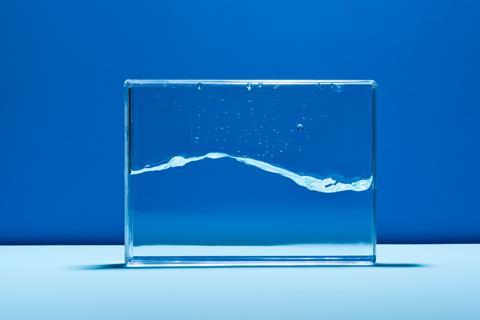The hydrogen-bonded network in liquid water resists compression; density increases instead arise from molecules moving into voids
The liquid state has always been a puzzle. The first proper theory to describe it, proposed by Johannes Diderik van der Waals in his 1873 doctoral thesis, presented it as a modification of a gas. By incorporating intermolecular attraction and finite molecular volume into the gas laws relating pressure, temperature and density, he predicted a sharp transition to a denser phase. In this view, the molecules in a liquid are more or less as disorderly as those in a gas.

But the density of the liquid is much closer to that of the solid. So mightn’t the solid phase be a better starting point, with the liquid emerging from an accumulation of defects, rather as in a glass? This perspective seems all the more apt for water, which is famously (notoriously?) a structured liquid, the three-dimensional hydrogen-bonded (H-bonded) network creating considerable local order in the local environment of each H2O molecule by arranging them into a tetrahedral formation. It’s because of this network that liquid water is in fact denser than the solid: the continual making and breaking of hydrogen bonds in the liquid allows molecules to drift into the interstices of the network that is rigidly maintained in ice.
This allure of an icelike model for liquid water has tantalised many. In 1892 Wilhelm Röntgen proposed a two-phase water model in which microscopic clusters of ice floated in a more disorderly medium; such a two-state picture was championed a century later by Wilse Robinson and coworkers.1 The spirit of those ideas can be discerned in the proposal2,3 that water has two liquid states of different density – one might say a gaslike and icelike phase – which simulations predict will phase-separate in the metastable low-temperature, high-pressure region of the phase diagram.
At the root of this debate is the thorny question of how to capture the dynamic state of the liquid in a static structural model. How do you decide if any given H2O molecule is part of one phase or another, or if any meaningful distinctions exist at all?
There is no perfect way to measure water structure
New experiments by water-structure veteran John Tse of the University of Saskatchewan in Canada and coworkers have now shown how to do so.1 They have asked how the structure of water changes at high pressure – a question of more than academic interest, as it bears on the issue of how organisms survive at the enormous pressures of the deepest oceans.
New experiments led by water-structure veteran John Tse of the University of Saskatchewan in Canada, Christoph Sahle at the European Synchotron Radiation Facility, France, and Christian Sternemann at Technical University Dortmund, Germany, have now shown how to do so.4 They have asked how the structure of water changes at high pressure – a question of more than academic interest, as it bears on the issue of how organisms survive at the enormous pressures of the deepest oceans. Given how sensitive biomolecular interactions are to their hydration environment, any change in water structure might be expected to have implications for molecular biology.5
The problem here has always been that there is no unique or perfect way to measure or quantify water structure. Neutron and x-ray scattering, infrared, Raman and terahertz spectroscopy have all been used, supplemented by simulations. Tse and colleagues use x-ray Raman scattering (XRS) spectroscopy, in which changes in local hydrogen-bonding register as subtle changes to the scattering from oxygen atoms. By comparing their observations with XRS spectra calculated by ab initio methods from molecular dynamics simulations, the researchers deduce what increasing pressure does to the liquid structure.
They conclude that the H-bonded network is not itself significantly disrupted. Rather, squeezing induces some H2O molecules to inveigle their way into the voids of the network and thus to enter the first coordination shells of other molecules, giving them a fifth near neighbour that is not H-bonded. There is then in a real sense a distinction in the types of molecules in the local environment of any given H2O molecule: some are part of its H-bonded network, some are not (although those appear to be a part of the network formed with other molecules).
This picture can be related to the situation when ice is squeezed. Ordinary ice has an extraordinary number of other structures, the possibilities enabled by the many ways the relatively open network can respond to pressure by increasing its density. The interstitial voids can collapse, for example, disrupting the H-bonding; or, at very high pressures (in the phases ice-VI and ice-VII), the network can rearrange to form two distinct, interpenetrating sublattices. A disordered version of that interpenetrating structure has been reported for the high-density form of amorphous ice.6 In this telling, if you want to understand water under high pressure, start with ice.
There is a corollary to all this. Like most liquids, water is generally regarded as incompressible. But this scope for squeezing molecules into voids gives it rather more latitude than others have, if the pressure is high enough. And indeed it displays an unusually large density increase of around 25% at 10 kbar pressure. Water-jet cutting tools come close to that, operating at up to 6 kbar and making a significantly denser liquid to add to the punch that, when assisted by suspended abrasive particles, can slice through metal plates.
References
1 M Vedamuthu, S Singh and G W Robinson, J. Phys. Chem., 1994, 98, 2222 (DOI: 10.1021/j100060a002)
2 P H Poole et al., Nature, 1992, 360, 324 (DOI: 10.1038/360324a0)
3 L Kringle et al., Science, 2020, 369, 1490 (DOI: 10.1126/science.abb7542)
4 M Förster et al., PNAS, 2024, 121, e2403662121 (DOI: 10.1073/pnas.2403662121)
5 M A Schroer et al., Phys. Rev. Lett., 2011, 106, 178102 (DOI: 10.1103/PhysRevLett.106.178102)
6 S Klotz et al., Phys. Rev. Lett., 2002, 89, 285502 (DOI: 10.1103/PhysRevLett.89.285502)
1 M Förster et al., PNAS, 2024, 121, e2403662121 (DOI: 10.1073/pnas.2403662121)

















No comments yet